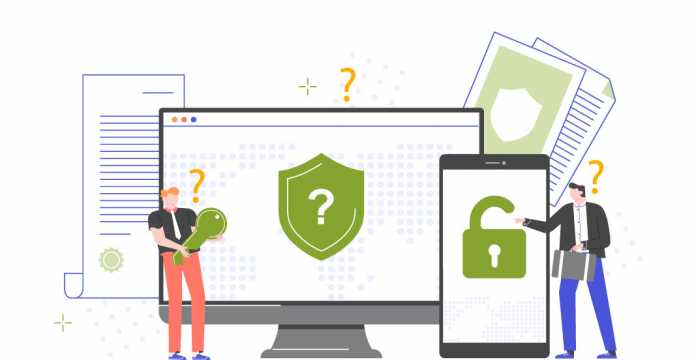
Cybersecurity jobs have been one of the most desirable jobs in today’s challenging IT business landscape. If you want to break into the cybersecurity domain, then cracking the interview is something tricky and challenging. If you are a seasoned professional, then brushing up on the latest trending topics in the IT Security domain will keep you in a good position, but if you are a fresher and are looking to become a cybersecurity professional, then having a strong foundation knowledge about cyber security is critical along with knowledge of top cyber security interview questions can be beneficial.
Here below, we have compiled a list of top cyber security interview questions with answers to assist you in cracking the Cybersecurity interview.
Q1. What is the information leak, and what causes it?
Answer: Unapproved transmission of data to an independent event or destination from within an organization is known as information leaks.
The many contributing factors to the data leakage are:
- Failing passwords
- Robbing corporate assets
- Hackers’ exploitation of vulnerabilities
- Ransomware emails
- Brutal attacks
- Loss of red tape
- Phishing
- System faults or configuration errors
- Lack of safety features for shared drives and documents
- Unreliable backup
Q2. What distinguishes between IDS and IPS?
Answer: IDS is an interference exposure system that detects encroachments only and the administrator must be careful to prevent intrusion. Whereas the system detects the intrusion in IPS, i.e., Intrusion Prevention System, and also needs to take precautions to avoid the encroachment.
Q3. What is Cross-Site Scripting, and how to avoid it?
Answer: Cross-Site Scripting is also recognized as a client-side code injection, which aims to execute malicious scripts through malicious software infusion on a victim’s web browser.
Following practices may stop Cross-Site Scripting:
- Special character encoding
- Using HTML
- Filter XSS
- Validating user feedback
- Using the services/tools Anti-XSS
Q4. What are the Cybersecurity approach benefits?
Answer: Having a robust cybersecurity approach will help enterprises to:
- It defends the company from malware, hacking, social engineering, and phishing attacks
- It safeguards end consumers with data protection
- It offers adequate security both for data and for networks
- Recovery time increases following a security breach
- Provides access to only genuine users
Q5. What is a three-way handshake?
Answer: A three-way handshake is a tool used to establish a connection between a host and a client within a TCP / IP network. It is called a three-way handshake since it is a three-step process in which messages are shared between client and server. The next three steps are:
- The client sends SYN (Synchronize) data to the destination to verify if the server is up or has ports available
- If the server has open ports, it sends the SYN-ACK packet to the device
- The recipient knows this and sends a box of ACK(Acknowledgment) back to the server
Q6. What is SSL? Is it complete when it comes to encryption?
Answer: SSL is not for encryption of problematic files. It is a technique of identity checking to recognize that the person you are referring to really is who they think they are. SSL and TLS are used nearly everywhere and by everyone, and due to this prevalence, it runs the risk of being targeted by its deployment and its well-known technique (e.g., The Heartbleed bug). For information-in-transit and data-at-rest, additional protection is necessary, as SSL can be quickly stripped in some circumstances.
Q7. Explain the Traceroute
Answer: It is a device that displays the direction of the packet. It lists all of the points that move through the packet. Traceroute is often used when the packet isn’t touching the destination. Traceroute is used to verify whether the connection fails or ends, or the fault is detected.
Q8. What are the steps to building a firewall?
Answer: The steps to configure a firewall follow:
- Username/password: Update a firewall device’s default credentials
- Desktop administration: Deactivate the remote control function
- Port forwarding: Enable sufficient port forwarding to function correctly for some programs, such as a user’s computer or FTP server
- DHCP server: Adding a firewall with an existing DHCP server on a network would create a conflict unless the DHCP firewall is removed
- Logging: Ensure logging is allowed and understands how to display logs to troubleshoot firewall problems or possible attacks
- Protocols: You should have sound security policies in place and customize the firewall to implement those policies.
Q9. What are the methods used to avoid a password attack by brute force?
Answer: There are three methods for stopping an attack by Brute force login:
- Account Locking Policy: The account is shut out before the administrator unlocks the password after a set number of unsuccessful tries.
- Progressive delays: The account is disabled for a given time frame after three unsuccessful authentication attempts. The lock-out time will continue to rise with any failed login session after this, thus making it impossible for the tools to try forced login.
- Challenge-response test: This is mainly to stop automated login submissions. Resources such as free reCaptcha can be used to ask the user to enter a text manually, or to solve a fundamental problem to make sure a user is a real human.
Q10. What is security with two variables, and how will it be applied for public websites?
Answer: Two-factor verification is also referred to as double-factor authentication, or two-step validation, in which the device requires two multi-factor authentications to encrypt user accounts and services while communicating.
Two considerations can be added to encourage more activism on your current account using a password on public websites like Twitter, Microsoft, LinkedIn, and more!
To allow this double factor authentication, you can easily go to settings, and then manage security settings.
Q11. Explain data leakage
Answer: Data Leakage is the deliberate or accidental transfer of data from inside the enterprise to an unintended external destination. It is the disclosing to an unauthorized individual of classified knowledge. Data leakage can be broken down into three groups, depending on how it happens:
- Accidental breach: An individual accidentally transfers data to an unknown party because of an error or an accident
- Intentional Breach: The designated entity may submit data on intent to an unauthorized entity
- Device Hack: Using hacking methods to cause data leakage
The use of the methods, applications, and techniques known as DLP(Data Leakage Prevention) methods will prevent data leakage.
Q12. What is Phishing, and how to bypass it?
Answer: This is one of the frequently asked cyber security interview questions. Phishing is a social engineering assault designed to deprive users of info. Typically the data targeted are login passwords, credit card details, and bank account information designed to confuse or cheat people. The social engineer embodies legitimate web pages and demands usernames and other information.
Four ways to stop Phishing are:
- Two-factor authentication includes two methods for confirming the identity
- E-mails flagging high-risk
- Increased password logins with identity references
- Train your staff to guard against individual tell-tail e-mails and techniques for exchanging information
- Have a watch against Spam
Q13. What is Port Scanning?
Ans: Port Scanning is the method used to classify the available open ports and facilities on a network. Hackers use port testing to hack bugs and find details that can be useful. Using Port Scanning, administrators review network security policies. Some of the strategies popular for port scanning are:
- Check Ping
- Half-open TCP
- TCP Log in
- UDP Fix
- Stealth check
Q14. What is the CIA?
Ans: Confidentiality, Integrity, and Availability (CIA) is a standard model for designing a security strategy. The CIA model is composed of three concepts:
- Confidentiality: Ensure that an authorized person accesses the confidential data.
- Integrity: Integrity ensures the data is in the proper format.
- Availability: Maintain the appropriate data and services for those who use them.
Q15. How to avoid identity theft?
Answer: Here’s what to do to stop identity theft:
- Make sure the password is consequential and special
- Don’t exchange sensitive information online, especially on social media
- Buy from reliable and established websites
- Using the new Web Update
- Download sophisticated malware and spyware software
- Using advanced protections against financial data
- Update your device and apps forever
- Secure your Social Security Number (SSN)
Conclusion
Make sure you’ve done your preparation about what a traditional cybersecurity job is, and what benefits you can receive at this point of your career. Finally, end the interview with a short description of your skills and how well you’re fit for the role. Using the questions posed by the interviewer and the responses to underline the qualities they are looking for.
Companies are interested in people, and you’re not a server who offers remote answers. You are a person with relevant expertise, however, you can rely on to answer questions about cybersecurity and make the argument that you are the best fit for the job.
To learn more about cybersecurity, you should consider pursuing some of the popularIT Governance Certification Courses from an accredited training provider.
Some of the popular IT Security and Governance certification courses that professionals can take up are:














